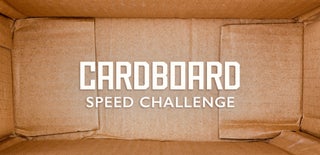Introduction: Levitating Side Table Made From Old Cardboard Boxes
When I was looking for something cool and fun to make during these indoor quarantine days, I stumbled upon tensegrity models. It's really interesting physics and saw mainly tiny models, so I wanted to try and build it larger with a bit more ability to lift some light objects :-). The optical illusion is my favorite part of the final result and maybe the best part is that it doesn't require a lot of time or difficult materials so anyone can start to make something like this!
Step 1: Draw Your Parts on the Cardboard and Cut Out
Step 1 is about cutting the parts you will need. We will begin with 4 squares of 19 x 19 cm. then make 4 legs as shown in the photo. 9,5cm wide and length 37cm. Next you will need 2 squares of 5 x 5 cm cut into triangles. Cut a few strips of thin cardboard that are going to be used to cover up the edges later. These strips will be as wide as 2 of the legs on top of each other so twice the cardboard thickness. The cardboard I used here was 5mm thick so I had to cut the strips to 10mm wide.
Step 2: Hot Glueing the First Parts
Glue 1 of the squares on top of another one and repeat that with the other 2 squares so you end up with 2 double stacked squares. Do the same with the table legs (2x2). Glue the table legs onto the squares in the middle and on the edge. Use a triangle ruler or anything else to make sure the angle is right. Later reinforce the leg with the cardboard triangles (5x5cm) you made earlier.
Step 3: Time for the Magic Rope and Detailing.
Use sufficient glue to mount the piece of rope onto the leg as in the picture. Next step is a bit of an esthetic one and that is to cover all the open cardboard edges (only the first leg/square). This also makes the leg stronger.
Step 4: Join the 2 Table Parts Together
Glue the other end of the rope onto the second leg. I kept a distance of 9 cm between the 2 parts. After connecting the 2 parts you can finish up table part 2 with the strips like you did in the previous step.
Step 5: Make a Temporary Frame.
This is an important step. Before you can apply the thread for balance, you need to position both parts as good as you can. I used 4 pieces of cardboard to hold the floating part horizontal. What is important is that the rope in the middle is a little bit on tension. In this way your floating table top will hang in a straight position rather than hanging to one side.
Step 6: Adding Thread for Balance
Use your needle and thread to pierce trough the top surface and make a knot. Fixate the knot with a little bit of hot glue. Mine are on the bottom of the table top so you won't see them right away. When dry, pierce trough the bottom part and fixate with hot glue. make sure you don't pull to hard because this might have negative effect on the other threads.
Step 7: Remove the Temporary Frame and Try It Out!
Remove the frame and if everything is correct, you got yourself a floating table! :-) When you put on little weight for a test you will notice that the placement of the 'cargo' is very influential to the position of the floating top. Watch out with heavy stuff like flower pots or anything similar because that would require a more sturdy build version :-) Enjoy and amaze some people with your magic side table! :-)

Grand Prize in the
Cardboard Speed Challenge













